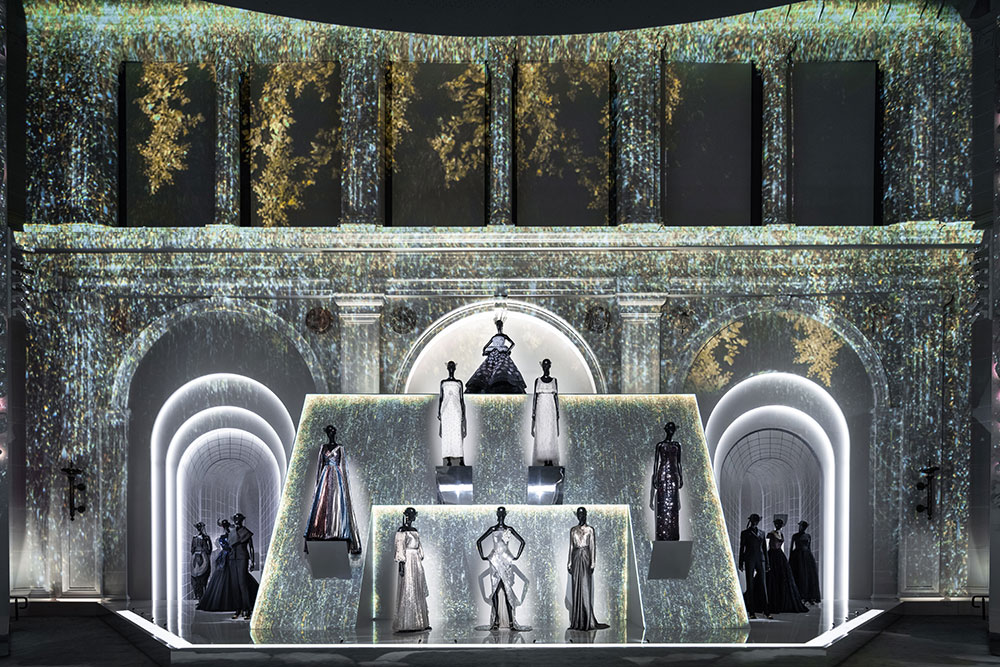
One of several extravagant displays at the “Christian Dior: Designer of Dreams” exhibit at the Brooklyn Museum of Art. Such as multimedia extravaganza–twinkling lights, “birds” chirping overhead, trees “rustling”– required the full underwriting of LVMH, the luxury conglomerate that owns the House of Dior. / Photo courtesy Brooklyn Museum of Art.
By Nancy McKeon
I SAW THE DIOR fashion exhibit at the Brooklyn Museum of Art recently and was dazzled. I also saw the new exhibit at the Metropolitan Museum’s Costume Institute and was . . . baffled.
The two shows are almost polar opposites. The Dior show is extravagant and billows across airy rotundas, mounted on temporary walls to awe-inspiring heights, then channels visitors through narrower hallways only to explode again into open space. The Costume Institute show is severe and cramped, individual pieces of clothing trapped inside a grid of translucent boxes, each embodying a word that the garment is said to exemplify, hence the name of the show, In America: A Lexicon of Fashion. But be careful not to step back for a better look at something: You’re certain to tread on someone’s Jimmy Choos.
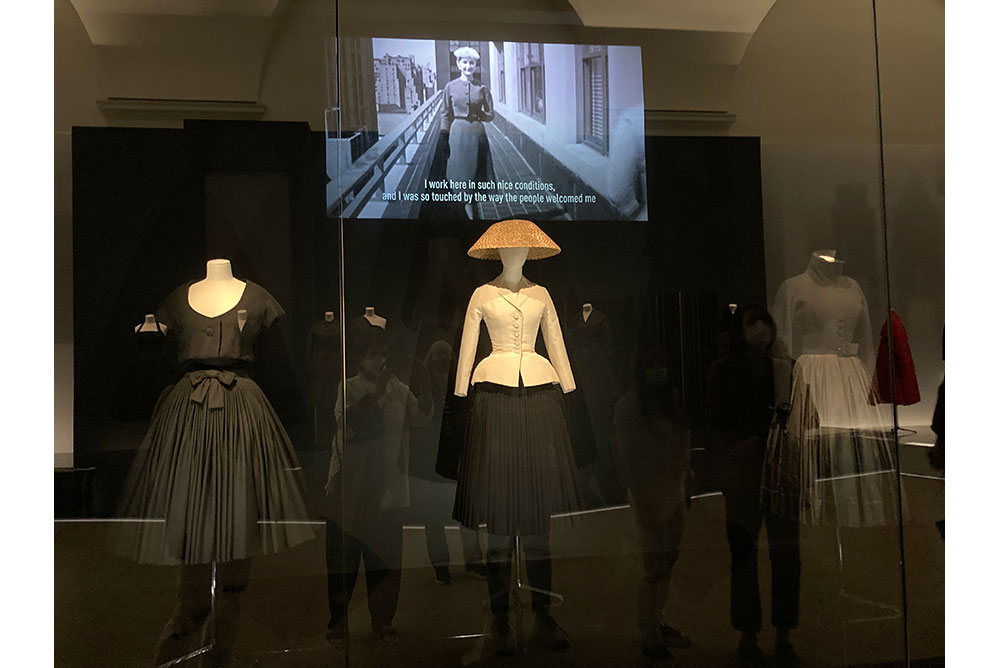
This was the 1947 silhouette, particularly the “Bar” suit in the middle, that announced the return of Paris to fashion primacy following the devastation of World War II. The “New Look,” so dubbed by Harper’s Bazaar editor Carmel Snow, took America by storm (even triggering picket lines of women protesting the lowered hem lengths, in a world that still followed fashion’s “dictates”). / MyLittleBird photo.
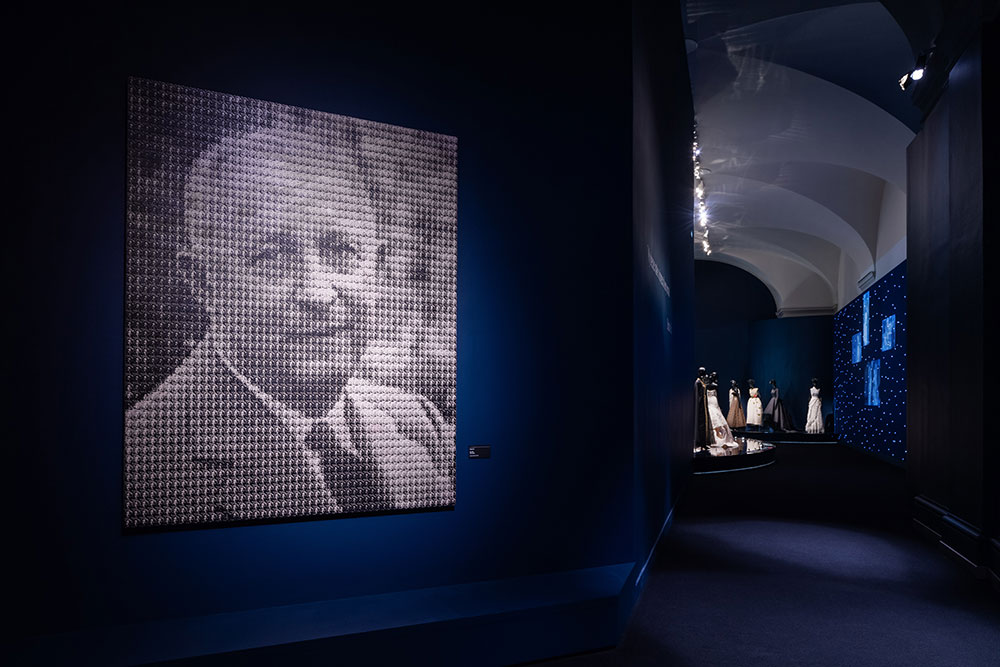
Greeting visitors to the Brooklyn Museum “Christian Dior: Designer of Dreams” exhibit is this photomontage of M. Dior, constructed of teeny-tiny images of Marilyn Monroe. / Photo courtesy Brooklyn Museum of Art.
Let me get one thing out of the way: The Dior show is a brilliant advertisement for the current-day brand, the design house founded by Christian Dior in 1946. The exhibit, which was mounted earlier in Paris, London and Shanghai, was underwritten principally by the company, now part of the luxury conglomerate LVMH, as was the lavish exhibit catalogue published by Rizzoli Electa, Christian Dior: Designer of Dreams.
So, in Brooklyn, we begin with press clippings of M. Dior in Paris after the war and, even more interesting, with the warm embrace he received from Neiman Marcus on his arrival in Dallas to promote the “New Look”—his strict “Bar” suit of 1947, with its high-armhole jacket and nipped-in waist with a peplum overlaying, in some versions, an explosion of gathered skirt, virtual acres of fabric that declared the end to wartime restrictions. (The New Look was such an event that there were even protesters posted outside Neiman’s whose placards declaring, “Mr. Dior, we abhor dresses to the floor.”)
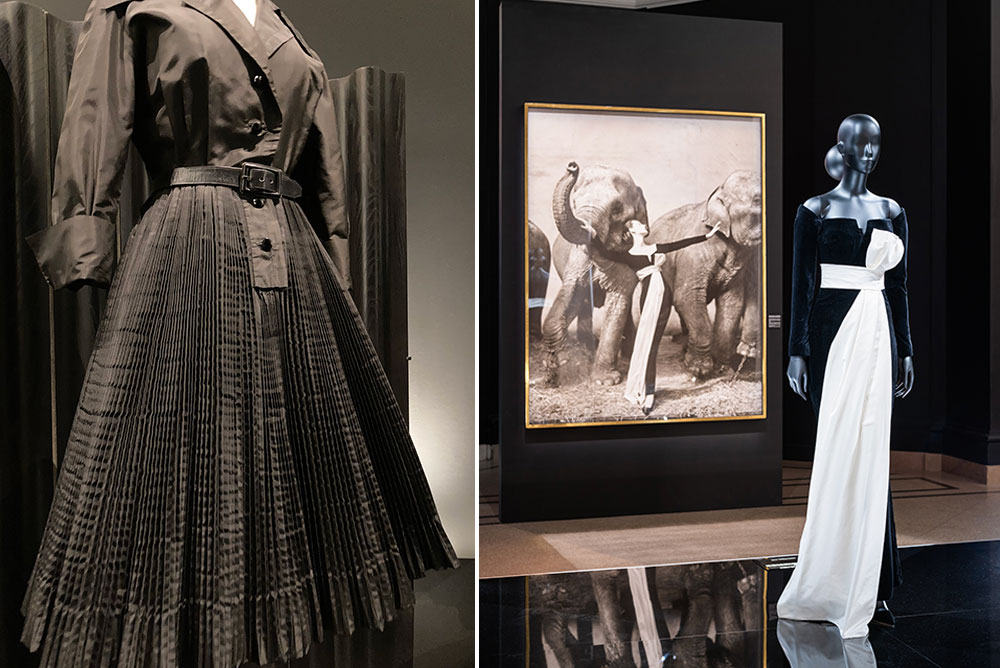
LEFT: As severe as early Dior day dresses could seem, there was an extravagance implied by the lavish pleating and exaggerated cuffs and collar. / MyLittleBird photo.
RIGHT: The Christian Dior exhibit includes the ways in which master photographers have celebrated the House of Dior’s styles. Here the famous 1955 “Dovima With Elephants” by the late Richard Avedon, featuring the model Dovima, is shown behind the actual “Soirée de Paris” dress from the Fall-Winter 1955 Haute Couture collection.
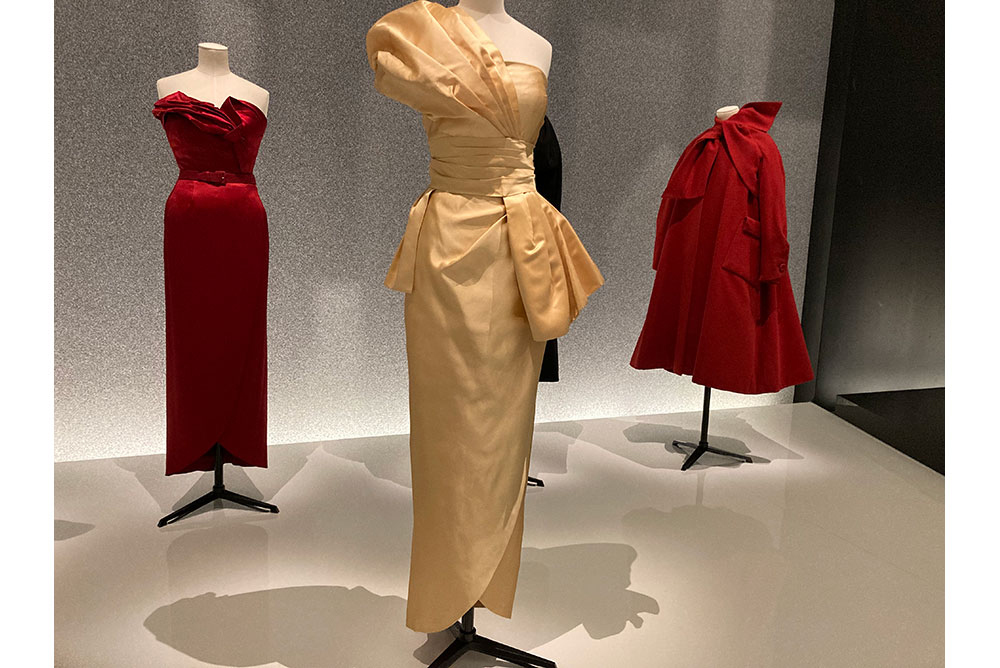
Garments from the Dior Heritage Collection on view include, on the right, the Haute Couture “Arizona” wool traveling coat from 1948 and the “Athena” long wrap evening dress in gold silk-satin from the Christian Dior – New York Fall-Winter 1951 collection.
There are lavish gowns shown, of course, but many of the early Dior day suits were a sober lot (you know, when ladies were ladies). Dior himself died suddenly of a heart attack in 1957, at the height of his fame, and subsequent vitrines show how his immediate successors—a very young Yves Saint Laurent, who had been his assistant, then Marc Bohan, Gianfranco Ferré, John Galliano, Raf Simons and currently Maria Grazia Chiuri—changed the Dior look with the times, sometimes tweaking it, other times re-creating it from whole cloth.
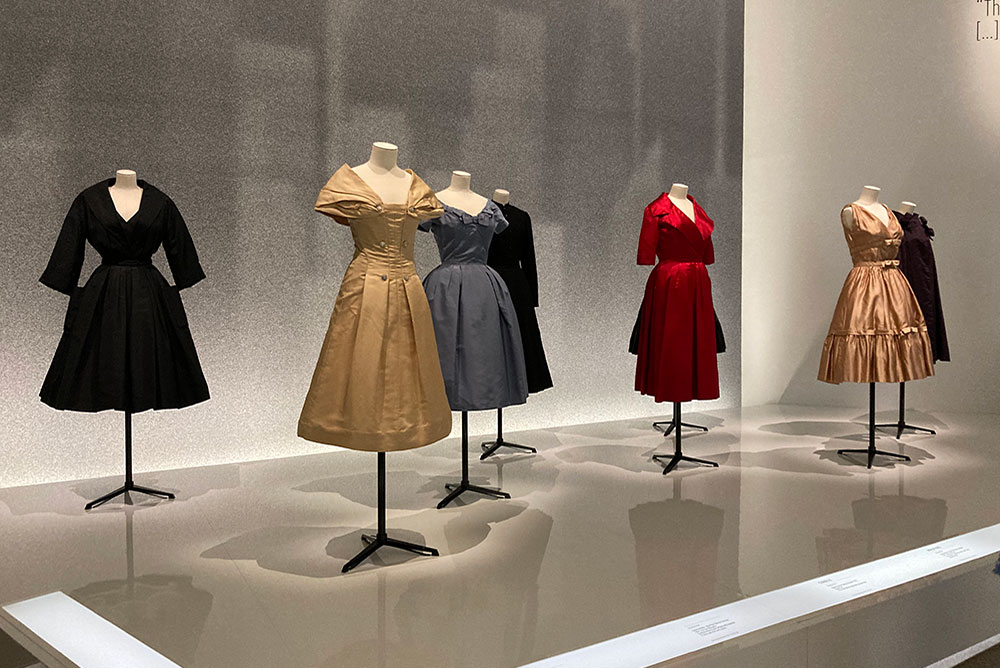
Early Dior silhouettes hewed to the wasp waist and full skirt, the latter marking the end of wartime fabric restrictions. / Photo courtesy Brooklyn Museum of Art.
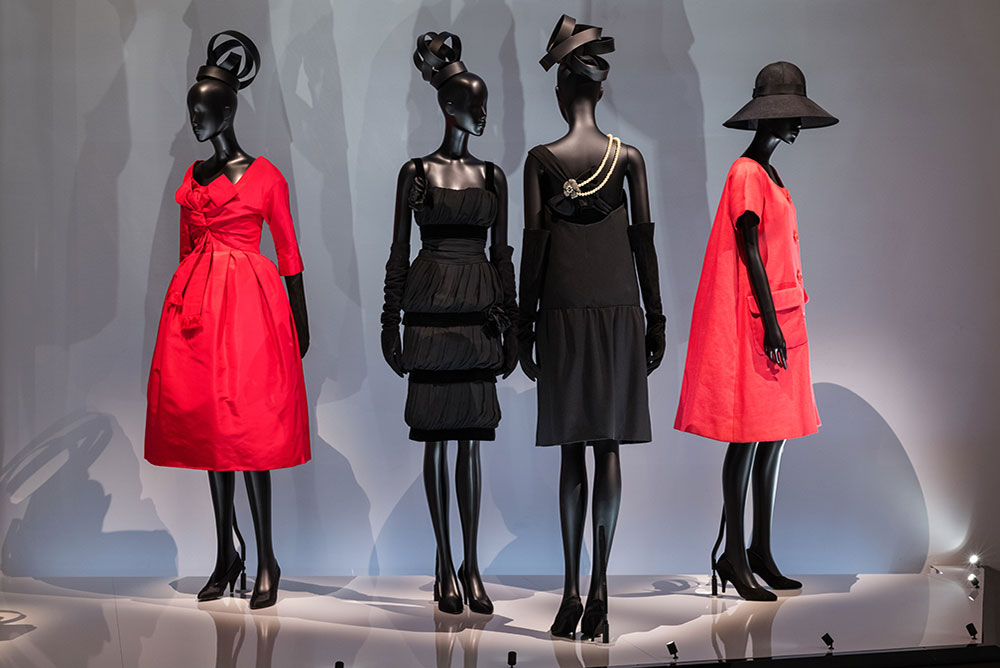
A young (21 years old) Yves Saint Laurent stepped into his master’s shoes immediately when Christian Dior died suddenly of a heart attack in 1957. Saint Laurent became known for injecting ethnic notes and a modern street sensibility into the House of Dior’s profile, but his contributions included a sure sense of tailoring and silhouette, as shown above. / Photo courtesy Brooklyn Museum of Art.
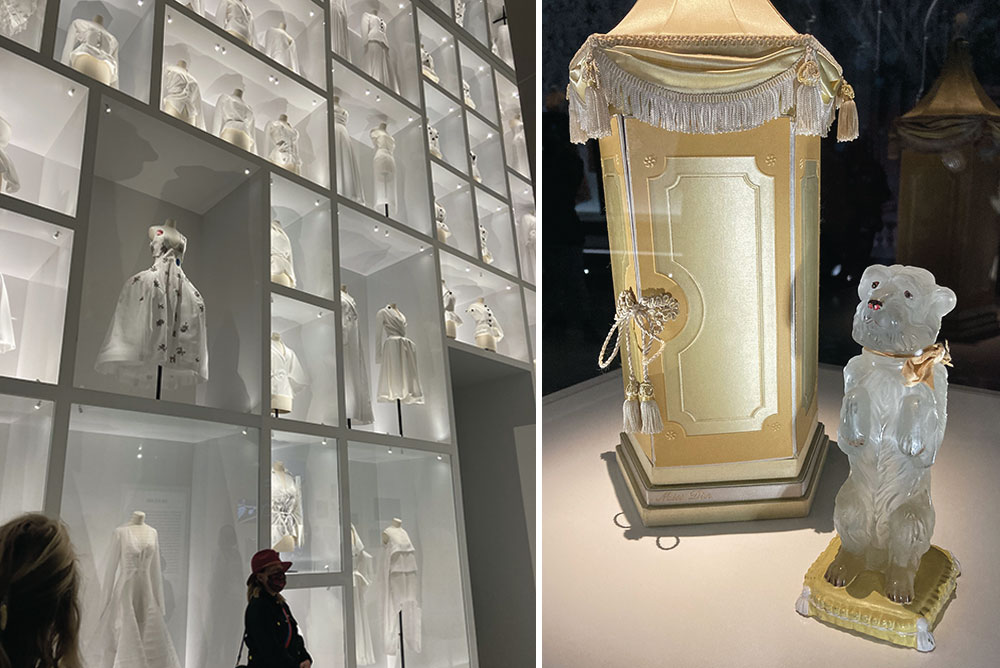
LEFT: The ethereal “Ateliers” section of the Brooklyn Museum Christian Dior exhibit.
RIGHT: Christian Dior’s first perfume, “Miss Dior” (named for his sister), came out in 1947. This glass bottle from 1952 was modeled on M. Dior’s dog, Bobby. / MyLittleBird photos.
If the sheer extravagance of the exhibit didn’t tip you off, the inclusion of current D.I.O.R. handbag charms and perfumes in the final exhibit area should allow the penny to drop, as the Brits used to say. But the commercialism doesn’t interfere with the pure pleasure of the show. At least it didn’t trouble me.
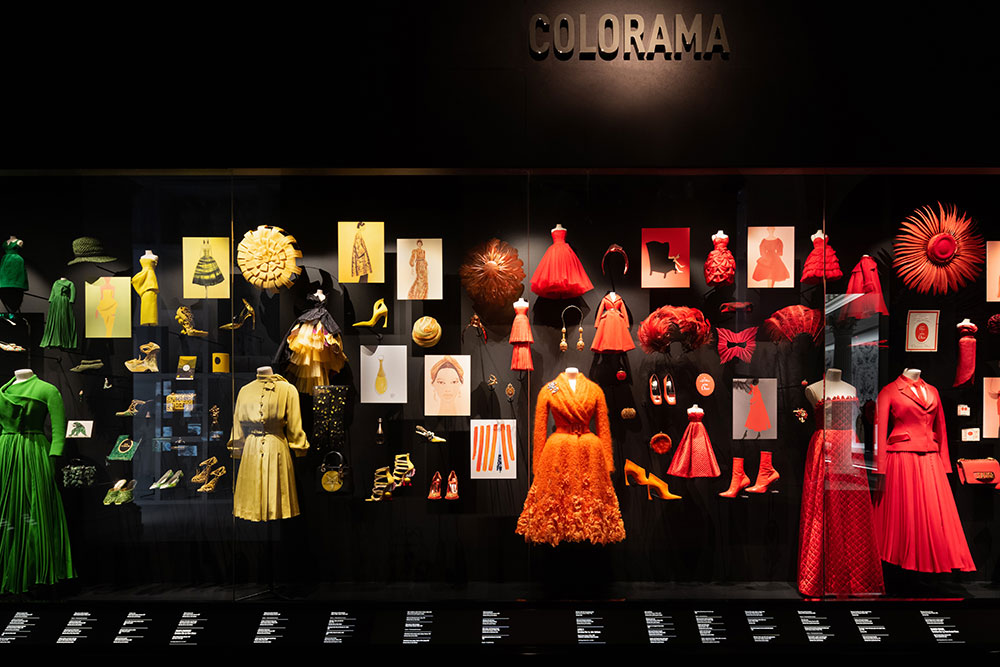
When the “Christian Dior: Designer of Dreams” reaches the “Colorama” section, applauding the design house’s bold palette, it begins to expand into the very commercial present, larding the exhibits with shoes and purses and perfumes that are very much part of the brand’s current offerings.
The Costume Institute’s American exhibit, whose second half will be mounted in 2022, can generously be called Dior’s ascetic, somewhat cerebral cousin. Too cerebral, perhaps, or is it quasi-cerebral?
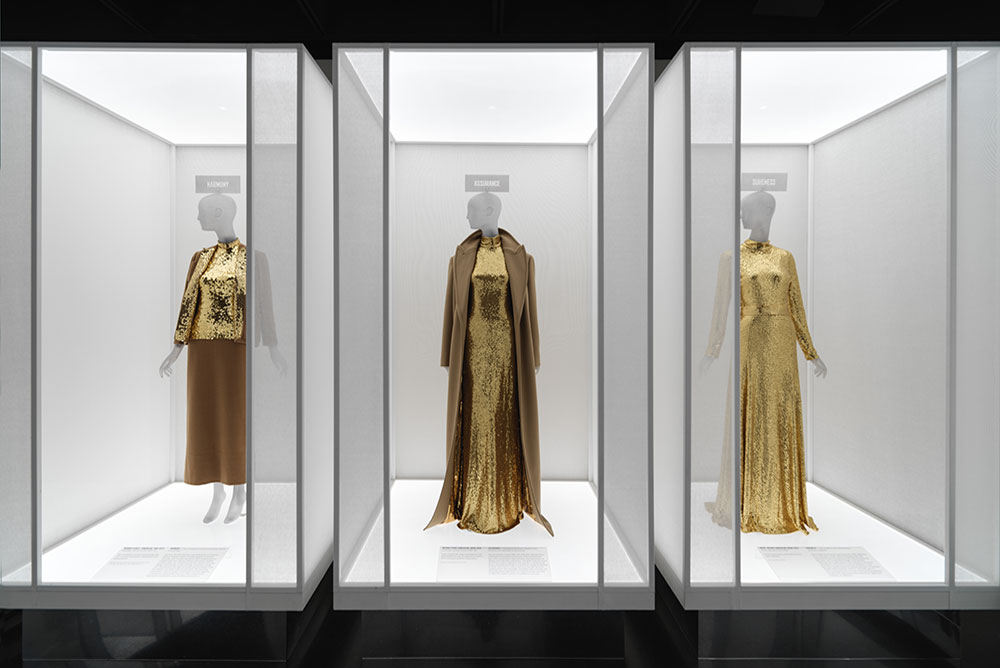
Gold paillettes evoke many feelings. In this portion of the Costume Insitute exhibit, the Norman Norell ensemble at left (camel wool skirt and jacket, the blouse and jacket lining covered in sequins; 1972-73) stands for Harmony. While Michael Kors’s 2021-22 ensemble in the center, the camel coat also lined with paillettes to mirror the gown, epitomizes Assurance. And the paillette-covered 2020 jersey dress by Marc Jacobs means Sureness. / Photo courtesy the Metropolitan Museum Costume Institute.
The organizing principle of American fashion as a patchwork quilt sent the curators on a scouting trip through the thesaurus in order to layer a whole glossary of words onto the clothing; not for their physical attributes, mind you, but for their purported emotional content. The resulting divisions and subdivisions (Allure, Grace, Romance, Intimacy, Sensuality and more come under the heading of Desire; Strength, Wonder and Delight are some other headers) would send the New Yorker’s estimable Comma Queen to her dictionary, and possibly her red pencil.
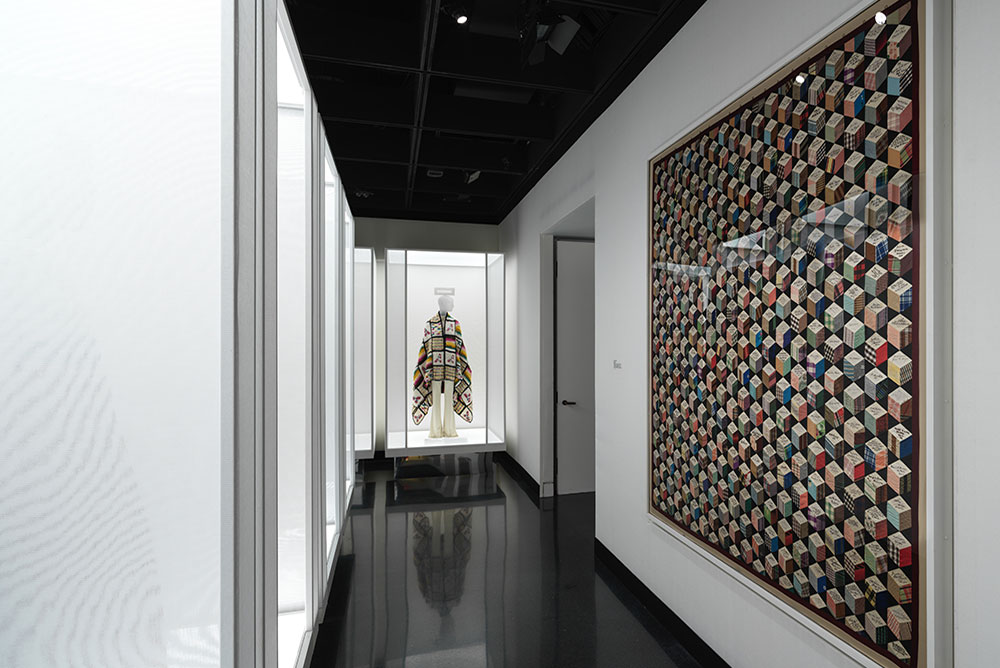
The cashmere ruana of Gabriela Hearst in the background is a nice visual juxtaposition with the “Signature” quilt by Adeline Harris Sears, executed in the Tumbling Blocks pattern. Beginning in 1856, Sears sent small diamond-shaped pieces of white silk to notables around the world, asking them to autograph the fabric. The resulting quilt includes the signatures of eight US presidents (including Abraham Lincoln), Northern heroes of the Civil War, plus arts and science luminaries. / Photo courtesy the Metropolitan Museum Costume Institute.
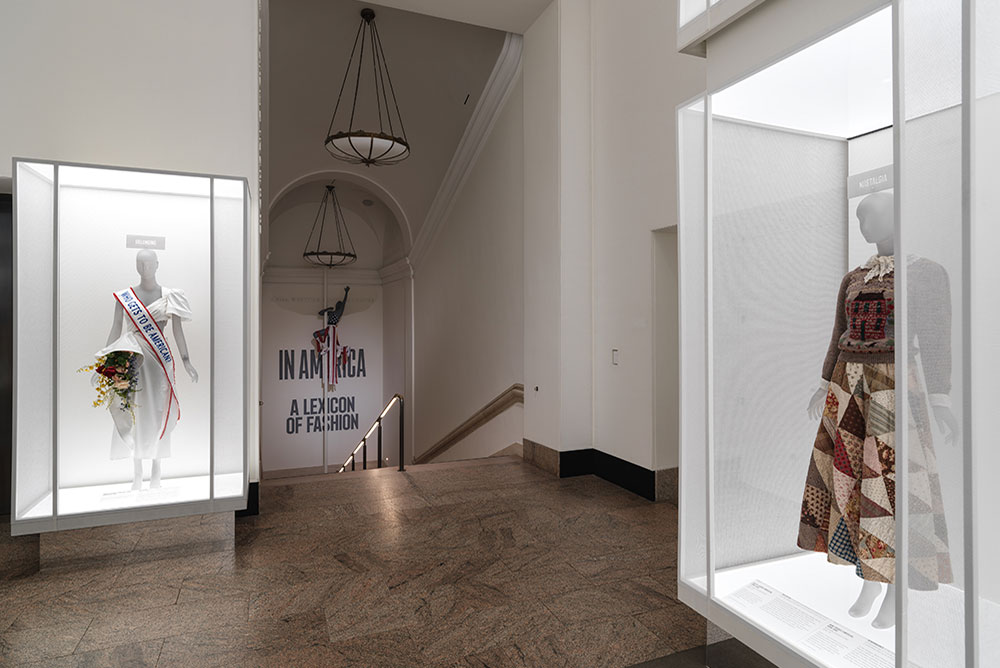
The overarching theme of the Metropolitan Museum Costume Institute’s exhibit, “In America: A Lexicon of Fashion,” is America as a patchwork quilt, an idea that clearly goes way beyond clothing and in fact stems from Jesse Jackson’s characterization of the country. A 1982-83 quilt-inspired skirt by Ralph Lauren sets the tone near the entrance to the lower-level lineup of designs. The outfit is also supposed to denote Nostalgia, one of the emotional words in the show’s “lexicon.” / Photo courtesy the Metropolitan Museum Costume Institute.
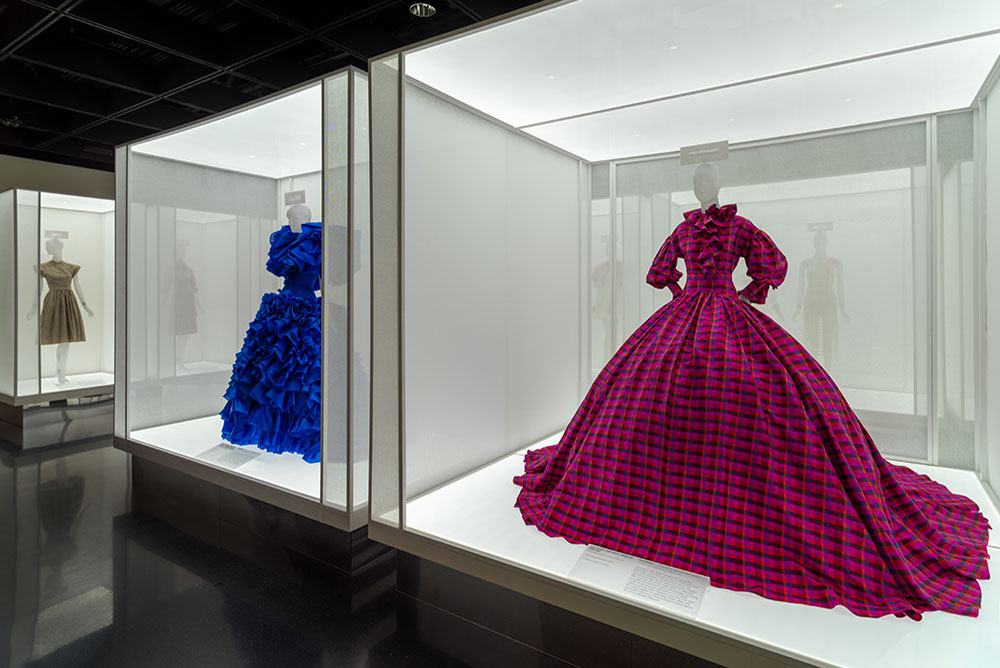
The blue silk organza confection by Rodarte (2019-20) stands in for Delight, while Christopher John Rogers’s plaid silk-taffeta ensemble from 2020-21 was dubbed Exuberance. Claire McCardell’s plaid cotton frock can be seen in the background. / Photo courtesy the Metropolitan Museum Costume Institute.
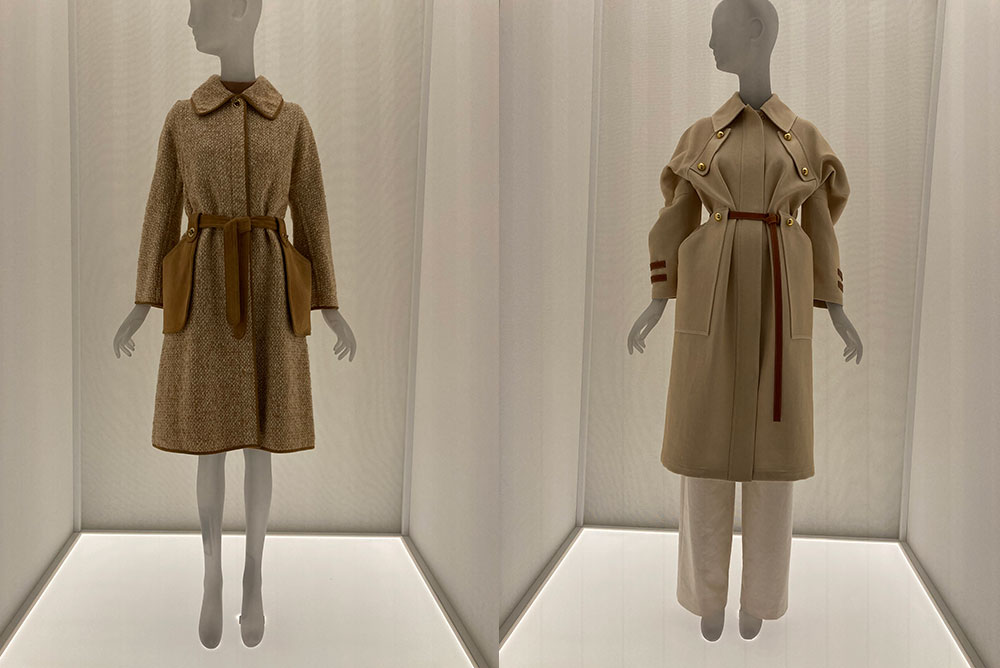
LEFT: The curators of “In America: A Lexicon of Fashion” see this 1973 Bonnie Cashion coat (for Philip Sills & Co.) as evoking Unencumbrance. The wool tweed is edged with camel suede, and its suede belt incorporates purse/pockets that were a Cashin innovation and do indeed leave the wear unencumbered.
RIGHT: Tory Burch’s 2018 cotton canvas coat recalls some of Cashin’s themes, incorporating pockets and leather belting, but her outfit is said to connote Ease.
/ MyLittleBird photos.
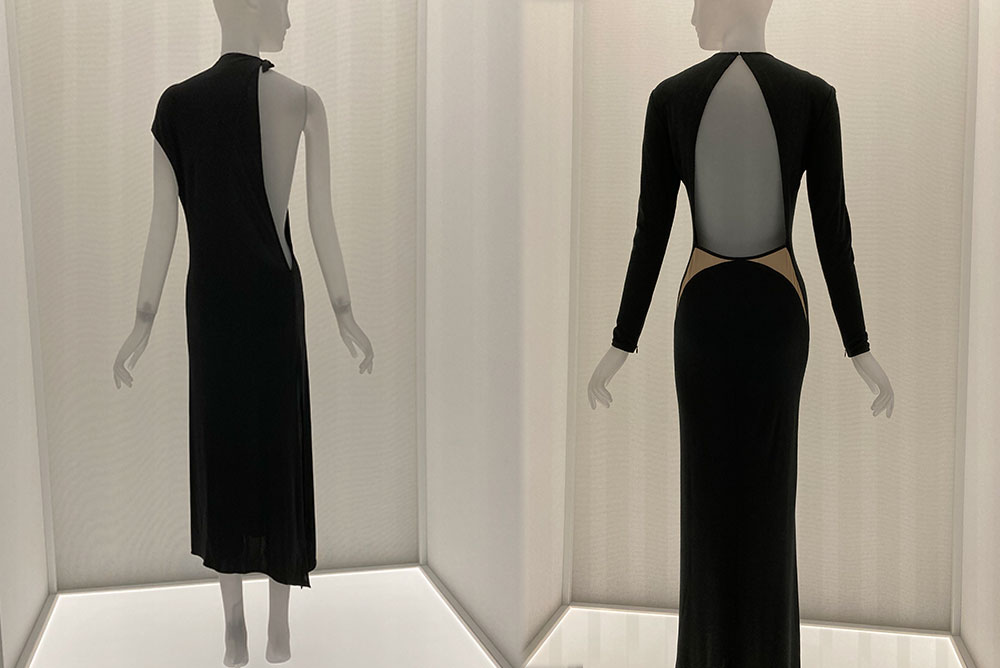
Designers have always played hide-and-seek with women’s bodies.
LEFT: Narciso Rodriguez carves a slice from this 2001-02 black silk jersey dress, enhancing a woman’s Allure.
RIGHT: Grace is the note struck by this black wool-Lycra dress from 1989-90 by the masterful Geoffrey Beene. The line of the hips is marked by nude tulle insets. / MyLittleBird photos.
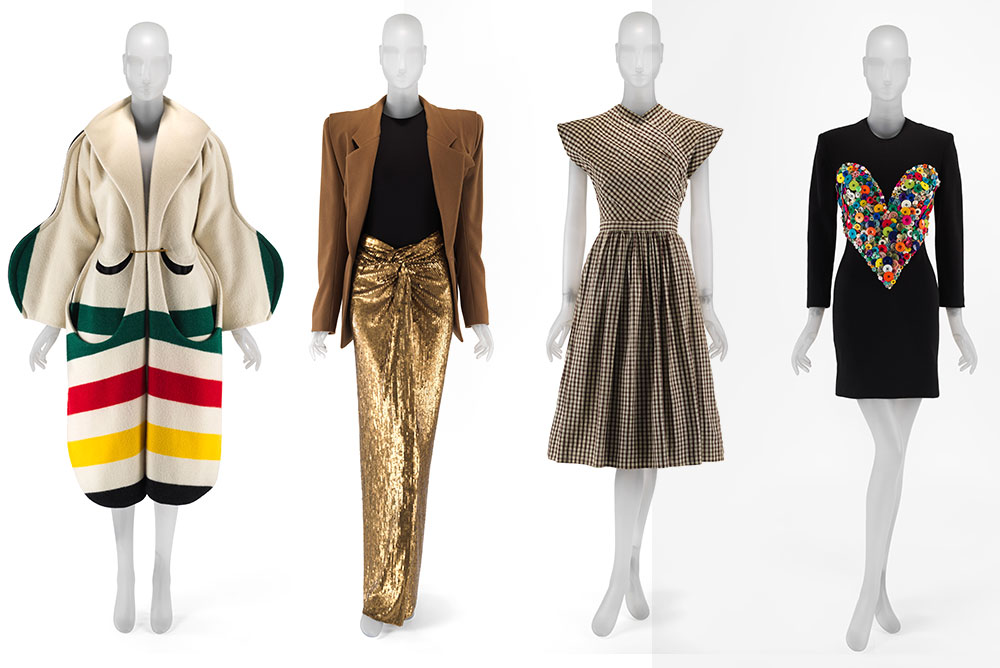
Examples of American fashion in the Costume Institute show include, from left:
Andre Walker used a Glacier National Park blanket from Pendleton Woolen Mills to make this 2018 coat denoting Comfort.
This ensemble from Donna Karan’s 1983 “Seven Easy Pieces” debut collection stands for Conviction.
Honesty dress of plaid cotton weave by Claire McCardell in 1943 for Townley Frocks.
Joy is the dress embellished with Patrick Kelly’s signature buttons; 1986-87.
/ Photos courtesy the Metropolitan Museum Costume Institute.
At risk of being branded a Philistine, I say ignore the words—they’ll just stymie you unnecessarily—and enjoy a stroll (well, more like a stutter step) through decades of American ready-to-wear: the ease of Claire McCardell and Bonnie Cashin, the sublime tailoring of Norman Norell and Charles James, the playfulness of Patrick Kelly, right up into the here-and-now of Michael Kors and Anna Sui and Marc Jacobs and Andre Walker and Virgil Abloh and Proenza Schouler and Libertine and The Row, and into the future.
Ideas about the future of American clothing are glimpsed in the final allée of garments—garments made with sustainability in mind (from recycled T-shirts, “deadstock” fabric), tailoring applied to street-tough silhouettes, pieces that attempt to redefine which sex should wear which piece of clothing (the non-binary designs of threeASFOUR).
Many of these ideas will not endure the way the denim of Levi Straus, also represented in this lineup, has. But there’s no need to worry about American fashion straying too far off the reservation: We’ve seen (some of ) the future, and it still promises sequins!
Christian Dior: Designer of Dreams, Brooklyn Museum of Art, 200 Eastern Parkway, Brooklyn, NY; www.brooklynmuseum.org. Through February 20, 2022. Timed tickets required.
In America: A Lexicon of Fashion, Metropolitan Museum Costume Institute, 1000 Fifth Avenue, New York, NY; metmuseum.org. Through September 5, 2022. Timed tickets required.

Love, love, love.
Beautiful post, Nancy! The Christopher John Rogers’s plaid silk-taffeta ensemble (wow) had me thinking of Scarlett O’Hara.
Joan, agree about Scarlett O’Hara! Some of the Met items are glorious to look at, but the future-looking stuff is where the eyes have to cede authority to the brain, cuz they’re definitely more challenging, more conceptual–they require WORK!!! to appreciate.
Janet
What a fun read! These exhibits are a must-do sometime in the next year – in comfortable shoes – stutter-stepping my way through a century of history as told through the emotions captured in fashion.
Thank you!